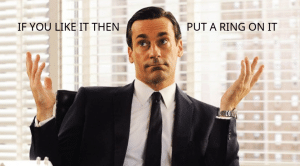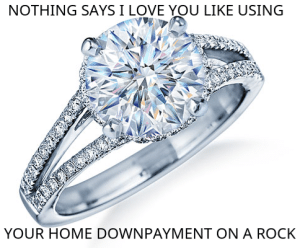This man above is directly responsible for the mass frenzy that occurs every few weeks when your girlfriend from college posts a pic of the engagement ring and rock she just got from her bae on Facebook or Instagram. You get a call from a friend, “Woa look of the size of that thing! He must really love her!” Well believe it or not, it wasn’t always this way, and it’s a case study on how marketing campaigns are designed to warp our emotions into creating artificial need and separating us from hard earned cash.
Back in 1938, the country was still reeling from the Great Depression. Asset prices were at rock bottom, and diamond prices were among the hardest hit. The most famous diamond company in the world, DeBeers, called on the famous Madison Avenue advertising firms of the day for a solution to their problem. They had too many diamonds and not enough demand from the younger generation of consumers to buy them.
Their strategy, developed by Gerold Lauck of N.W. Ayer Agency, was to market diamonds to both men and women (remember this is 1938 so kind of sexist by today’s standards). He put ads all over the place targeted towards men to make them feel like the measure of his rung on the ladder of social status was what type of diamond ring he could afford to buy as a promise of marriage. To women he placed diamonds in various high society, fashion, and movie venues and implied that the measure of a man’s love was demonstrated by the ring he bought you. Mr. Lauck even co-opted the British royal family into bringing diamond rings in vogue.
Initially, DeBeers suggested that the ring cost be equal to one month’s salary. The marketing campaign was going so well, a little while later they upped it to two month’s salary. Today, when friends are shopping for engagement rings I regularly hear three and four month’s salary thrown around as the proper figure.
This company DeBeers was extremely successful because they controlled virtually the entire world supply of diamonds. All they needed was a cultural mandate that would be a vicious cycle where everyone is afraid to not buy a nice big ring for the societal implication that you are not in love with your intended. Diamonds are a plentiful resource, the only constraint is how fast one wants to pull them out of the ground. I’ve been to one of the main diamond mines in South Africa and if they wanted to lower the prices they could easily do so but why? Everyone will buy them anyway so there is no need. Unfortunately, the money and profits from this smash hit campaign went to funding the apartheid government of South Africa for many years. Some diamonds today fund conflicts in Africa, made popular by Leo DiCaprio’s movie Blood Diamond.
A thought if you are considering buying a rock for your significant other. You can take the money you spend on it and put it towards things like a house, a car, an unforgettable honeymoon, or you can buy a shiny piece of carbon. Since there is utility in signaling to the dating market that you are no longer in play, I’ve seen some people opt for pearl rings in lieu of diamonds and they have taken the difference and used it to other purposes.
If you feel like it’s too important to have a diamond ring because you care about what other people will think or you just like the idea, that’s fine. I would think about spending no more than one month’s salary for one. For someone in a decent post college job, that figure is probably $4000 or so. There is absolutely no need in going over that no matter what the people in the sales dept at Zales tell you.
In case you are interested in more about the history of diamonds as THE jewel for engagement rings, check out this comprehensive look here
Cheers!
TMONEY


